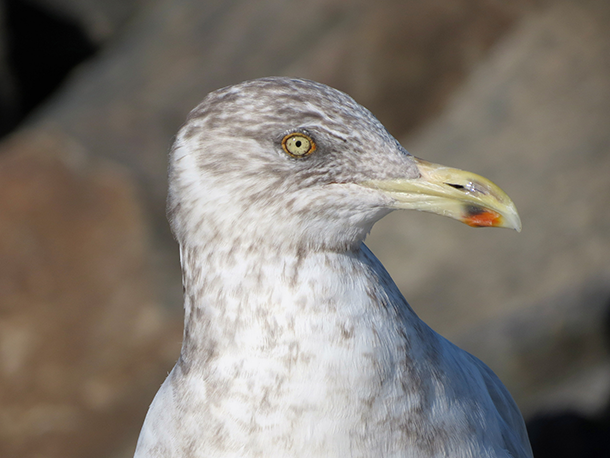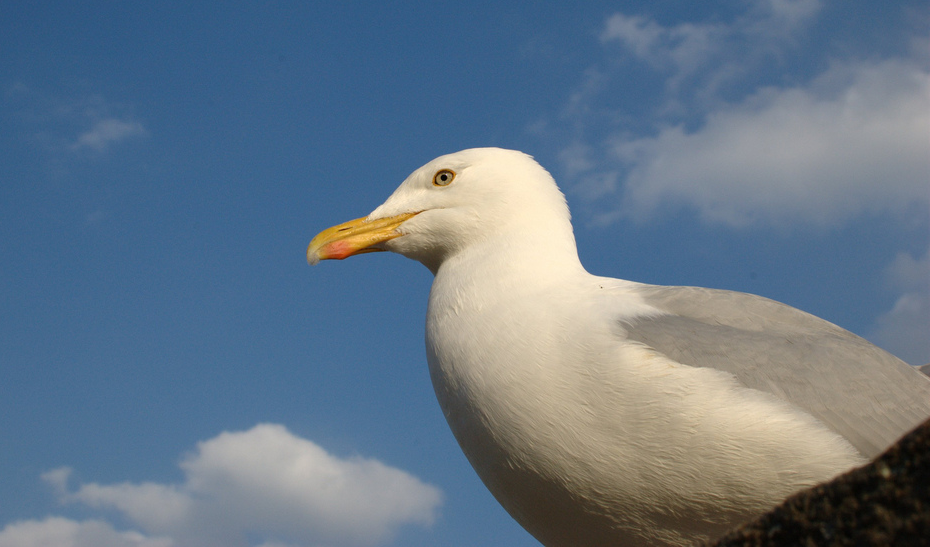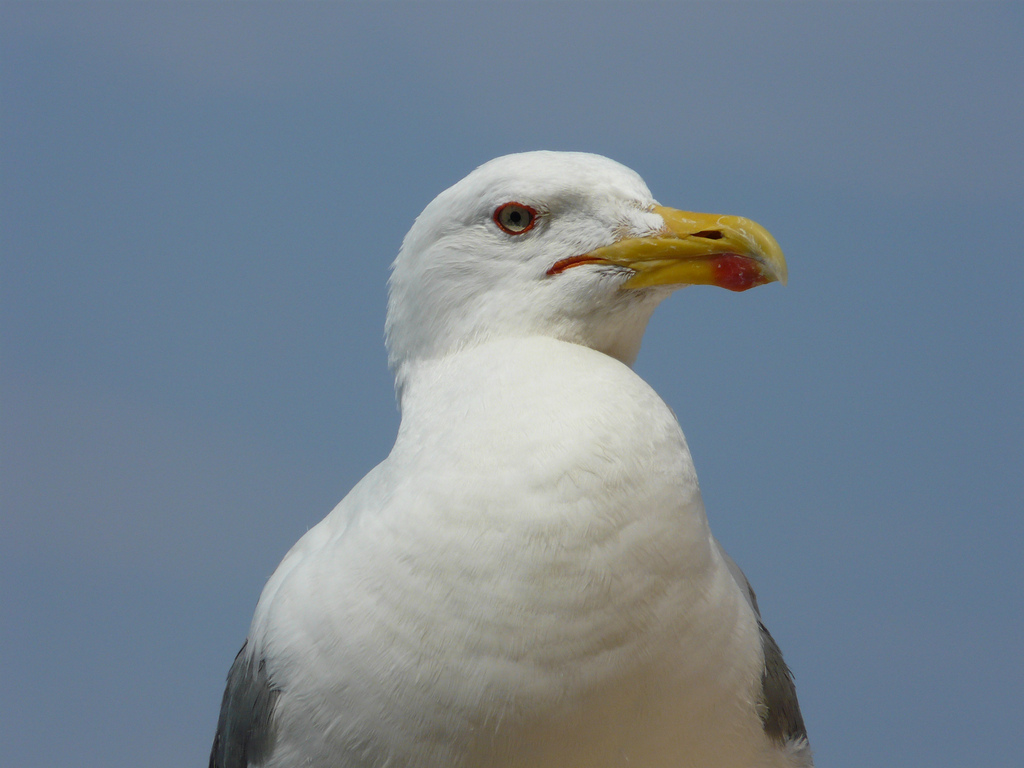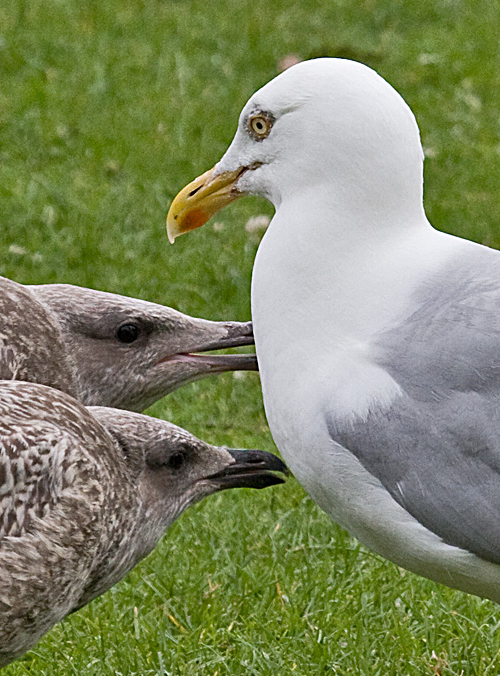BirdNote: Solving the Mystery of the Herring Gull’s Red Spot
Air Date: Week of October 3, 2014

An immature Herring Gull develops its own red spot. (Photo: Brian Henderson)
Mary McCann explains how a tiny red spot on the tip of a Herring Gull’s beak is a visual trigger for gull chicks and scientists — causing the young to feed, and setting off animal behavior experiments that led to a Nobel Prize.
Transcript
CURWOOD: It’s Living on Earth. I’m Steve Curwood.
[MUSIC: BIRDNOTE® THEME]
CURWOOD: The way animals behave is a constant source of fascination for some observers and an interest for scientists. And as Mary McCann explains in today’s BirdNote®, careful observation can help solve mysteries.
[GULL CALLS]
BIRDNOTE®/GULLS’ BEAKS
http://birdnote.org/show/little-red-spot-gulls-bill
The Little Red Spot on a Gull’s Bill
[Bugling calls of Glaucous-winged Gulls]
MCCANN: You may have noticed – on a trip to the shore or at a waterfront restaurant where gulls gather – that many gulls have a bright red spot near the tip of their otherwise yellow bills.

Herring Gull (Photo: mongolito404; Courtesy of BirdNote)
[BUGLING CALLS OF GULLS]
MCCANN: Behind that red spot lies a considerable tale – that’s t-a-l-e!
MCCANN: In the mid-20th Century, Dutch scientist Niko Tinbergen studied nesting Herring Gulls. He noticed that newly hatched gull chicks were fed by their parents only after they pecked at the adults’ bills
[BEGGING CALLS OF YOUNG GULLS]
MCCANN: Tinbergen devised experiments that varied the shape and coloration of the adult’s bill. It became clear that the red spot on the adult gull’s bill was a crucial visual cue in a chick’s demands to be fed, and thus its survival.

A mature Herring Gull looks out over the water. (Photo: Timelapsed; Courtesy of BirdNote)
[BEGGING CALLS OF YOUNG GULLS]
MCCANN: Tinbergen also made the case that the chick’s attraction to the red spot on the bill was instinctive. This conclusion came at a time when there was furious debate among experts about whether such behavior was learned or innate.
MCCANN: Tinbergen’s gull research helped lay the groundwork for the science of animal behavior, and in 1973 earned him a Nobel Prize. And it all started with that little red spot.

An adult Herring Gull displays its iconic red spot. (Photo: roamingwab; Courtesy of BirdNote)
[BEGGING CALLS OF YOUNG GULLS]
MCCANN: I’m Mary McCann.
###
Written by Bob Sundstrom
Bird audio provided by The Macaulay Library at the Cornell Lab of Ornithology, Ithaca, New York. Calls of Glaucous-winged Gulls recorded by A.A. Allen. Begging call of Glaucous-winged Gulls recorded by E.S. Booth. Herring Gulls recorded by Martha Fischer.
Producer: John Kessler
Executive Producer: Dominic Black
© 2014 Tune In to Nature.org October 2014 Narrator: Mary McCann

Herring Gull chicks peck at an adult in the hopes of a meal. (Photo: Tony Morris; Courtesy of BirdNote)
CURWOOD: You’ll find photographs of gulls – and their red spots - at our website, LOE.org.
[BEGGING CALLS OF YOUNG GULLS]
Links
Learn more about Herring Gulls and Tinbergen’s research on BirdNote’s website
Listen to another BirdNote from McCann on the Bushtit, a tiny songbird.
Living on Earth wants to hear from you!
Living on Earth
62 Calef Highway, Suite 212
Lee, NH 03861
Telephone: 617-287-4121
E-mail: comments@loe.org
Newsletter [Click here]
Donate to Living on Earth!
Living on Earth is an independent media program and relies entirely on contributions from listeners and institutions supporting public service. Please donate now to preserve an independent environmental voice.
NewsletterLiving on Earth offers a weekly delivery of the show's rundown to your mailbox. Sign up for our newsletter today!
 Sailors For The Sea: Be the change you want to sea.
Sailors For The Sea: Be the change you want to sea.
 The Grantham Foundation for the Protection of the Environment: Committed to protecting and improving the health of the global environment.
The Grantham Foundation for the Protection of the Environment: Committed to protecting and improving the health of the global environment.
 Contribute to Living on Earth and receive, as our gift to you, an archival print of one of Mark Seth Lender's extraordinary wildlife photographs. Follow the link to see Mark's current collection of photographs.
Contribute to Living on Earth and receive, as our gift to you, an archival print of one of Mark Seth Lender's extraordinary wildlife photographs. Follow the link to see Mark's current collection of photographs.
 Buy a signed copy of Mark Seth Lender's book Smeagull the Seagull & support Living on Earth
Buy a signed copy of Mark Seth Lender's book Smeagull the Seagull & support Living on Earth

